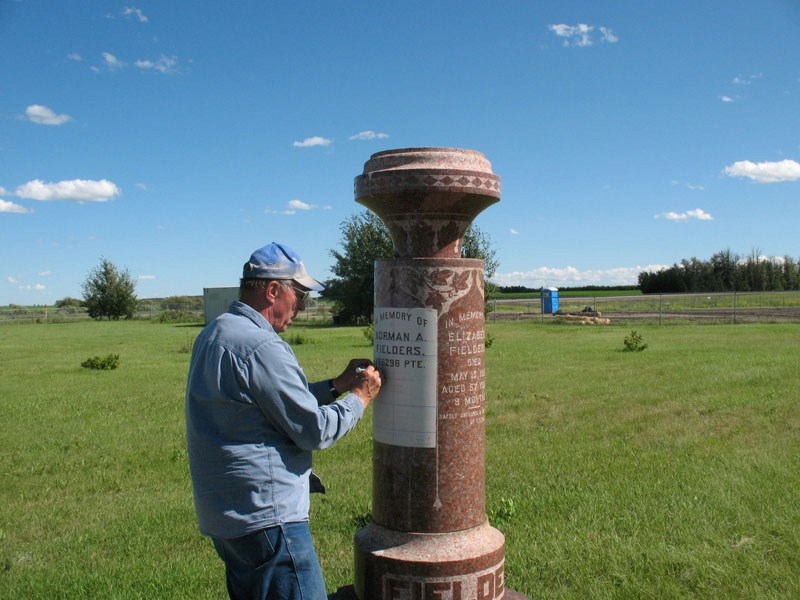The engraving is just a little deeper than the others on the rose-coloured memorial. The carving is a little more precise and the newly-exposed rock has 90 years less weathering than the other markings.
Despite the differences, the new memorial is for a man who died around the same time as the rest of his family and it closes the history on his life.
Earlier this month, with the help of a national charity, a local historian and with the consent of his descendants, the name of Pte. Norman Fielders was engraved into the Fielders' family memorial at the Poplar Lake cemetery near the Edmonton Garrison. The engraving comes more than 90 years after Fielders' death.
Fielders served in the First World War, fighting in French trenches in 1916. He survived the battlefield, but still died from the war. The conditions in the trenches caused his kidneys to fail and Fielders died in 1918 at home in Canada, before the last shots were fired, before peace was declared.
The Poplar Lake cemetery was his final resting place, but that fact was lost to history until last year when it was discovered by John Matthews, a local historian and volunteer with the Anglican Church of the Good Shepherd, who has been working on restoring the cemetery.
The small plot of land, just south of 195 Avenue near the Edmonton Garrison is home to 18 graves. Over many years the cemetery fell into disrepair. Matthews has been leading a volunteer effort over the last several years to clean up the site.
The Fielders' memorial is a roughly seven-foot tall cylindrical monument with four panels, three of which carried the names of Fielders' father, mother and brother. His brother and father both died in 1911 and his mother died in 1918 not long after Fielders' return to Canada.
Last year, when Matthews found clear evidence that Norman Fielders had been buried there he realized immediately that his name should be added to the memorial.
"It seems obvious, because there was a spare panel to the monument," he said. "That is why I look on it as being final closure."
Given Fielders' military service, Matthews got in touch with the Last Post Fund, a national charity that helps veterans' families with funeral expenses and also works to deal with unmarked graves.
Mary Jane Belec, a counsellor with the fund, said Matthews contacted her about Fielders and she immediately felt they could help.
"If we know that a veteran is buried and his grave is unmarked for more than five years we don't ask any questions we just mark them," she said.
A huge number of soldiers' graves were left unmarked for a wide variety of reasons, Belec said.
"Often war veterans died indigent and drunk and alone and estranged from their families," she said.
In other cases the family might have been financially strapped.
"It could be any number of reasons why they were not marked," she said.
In this case, when Fielders died, only a few of his siblings would have been around and they might not have had resources, Matthews said.
Belec said her organization has run into cemeteries with dozens of unmarked graves and are working on them as they have funds and resources.
"As we go on there are bigger and bigger projects for us to do," she said.
Cemetery restored
Dot Keichinger is one of the family members Matthews has been in contact with about the project. She said she has no idea why her great uncle's grave was never marked.
She said his death has been harder for her to track, when working on family genealogy, and the information on him has been limited.
"I presume there was an obituary, but I have never seen it," she said.
Keichinger and several other family members visited the memorial last Friday. She said it is a relief to see the cemetery has been restored and cleaned up.
She began writing letters to the Anglican Church in the late 1980s to try and have the site restored. She said at that time it was an absolute disaster.
"The whole thing was basically covered with trees and there was a broken down barbed wire fence around it and there was old furniture and garbage thrown everywhere in there."
She said even though they are distant ancestors they are still important.
"It is my ancestors, my great grandparents are buried there and my great uncles and I wouldn't like to see any cemetery like that," she said. "Those people, they are Alberta."
Matthews, who has been researching the cemetery for several years now, said he will continue trying to figure out who was buried there and do his best to mark their final resting spots.
"I would not say that the research phase is over by any means," he said.
More information about the site can be found at www.goodshepanglican.org/PoplarLake.htm and more information about the Last Post Fund can be found at www.lastpostfund.ca




